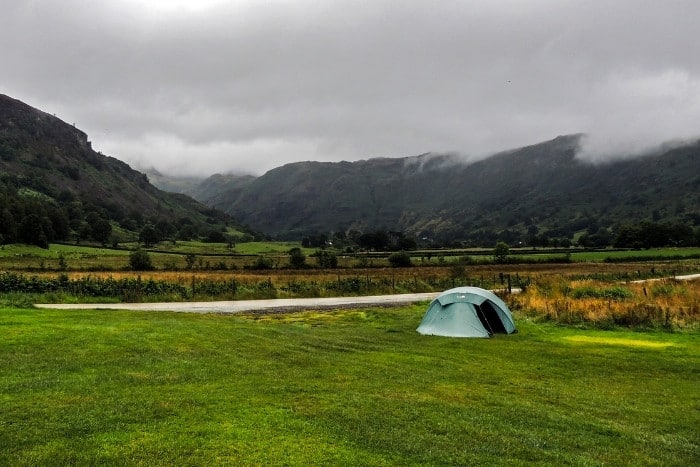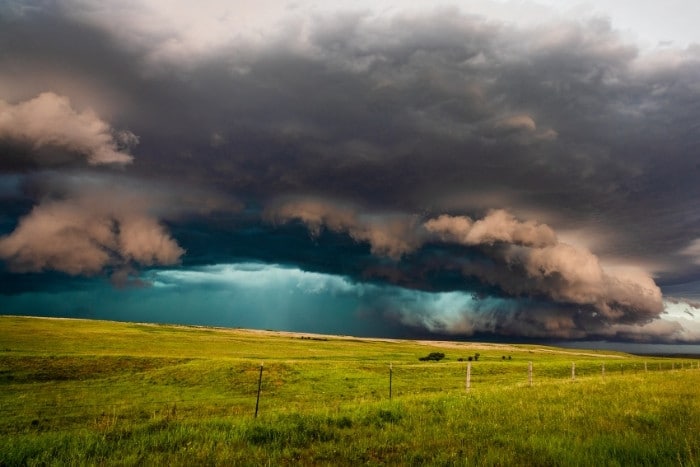Tent camping is one of my favorite summer activities. I love sleeping under the stars, listening to nature, and spending time outdoors. Unfortunately, having a tent also means being vulnerable to damage from the elements. While some tents have built-in rain covers, they don’t offer protection against lightning strikes.
Using a grounded sleeping mat, avoiding setting up camp near big trees, using a lightning rod, and staying dry are a few things you can do to make your tent lightning-proof. Camping during a thunderstorm is bound to make one feel uneasy but can be safer if precautions are taken.
If you want to learn more about how you can make your tent lightning-proof and whether it’s safe or not to camp in a thunderstorm, we’ll give you all the information you’ll need about camping when there’s a thunderstorm.
Protecting Your Tent from Lightning – What Do You NEED To Know?
The first thing you should do before going on any outdoor adventure is to check if there are any storms in the area. If you see clouds gathering above, it might be best to postpone your trip.
But let’s say you find yourself camping, and a thunderstorm is heading your way. What do you do? Find out where the nearest shelter is located. You could use Google Maps to help you find a place to stay.
It’s important to note that most shelters have limited capacity, so you may end up waiting hours just to get into them. However, if you’re lucky enough to find an open shelter, you should take advantage of it.
How can you be safe if you’re not close to a shelter and are stuck in your tent? These tips below will help in that situation.
You can’t avoid lightning altogether, but you can reduce its impact by following these simple steps:

1. Make Sure Your Tent Is Grounded
The ground wire attached to the tent pole must touch the ground. The easiest way to achieve this is to attach an extension cord to the tent pole and connect it to the ground using a clamp.
There are also grounded camping mats available which you can buy at camping stores. These mats are designed to provide a stable surface for people to sleep on while protecting them from lightning.
If the worst happens and you get hit by lightning, the sleeping mats will help redirect the electric energy to the ground, which could be life-saving.
2. Pitch Your Tent Away From Trees
Contrary to popular belief, trees act as antennas and attract lightning. They also provide a good source for the electricity to pass through, which makes them dangerous.
In some cases, you can see these giant trees get hit by lightning and catch fire. The fire hazard risks and the higher chance of getting hit make it one of the worst places to stay under during a thunderstorm.
3. Metal Objects Inside The Tent Are A Strict No-no!
Car batteries, power tools, phones, etc. These items can cause sparks which can lead to an electric shock.
It’s believed that being on your phone can also attract lightning, but it’s not scientifically proven, even though there have been cases of people talking on the phone getting hit by lightning.
4. Use A Lightning Rod
A lightning rod is a metal object that attracts lightning and redirects it away from you. It works by creating a circuit between the negative charge of the cloud and the positive charge of the rod.
As soon as the two meet, they create a spark which is why it’s called a “lightning rod.”
Different rods are available depending on their size, shape, and material. Some of the common ones include copper, aluminum, and steel.
5. Keep Your Tent and Yourself Dry
When it comes to staying dry, you need to keep yourself covered with something like a poncho or raincoat. Also, wear shoes instead of socks because they tend to conduct electricity better than bare feet.
6. Move To A Lower Altitude
A tent alone won’t attract lightning, but if you’re camped at a high altitude (such as on top of a mountain) near tall trees or buildings, you could be in danger.
If you’re camping in a location with many tall trees, you might want to consider moving to another area.
That being said, it doesn’t mean you shouldn’t go camping when there’s bad weather. There are ways to protect yourself from lightning while still enjoying the outdoors.

7. Use Tents With Non-Metallic Poles
Well, tent poles are not directly responsible for attracting lightning. Scientifically, nothing attracts lightning; it just tries to find a quicker way to hit the ground.
However, if your tent poles are made of aluminum or steel, they will increase the chance of getting hit by lightning.
That’s not a big enough issue, as most newer tent models now include poles made out of carbon fibers or plastic. These materials are not conductive at all, so you’ll be safe.
In contrast to having metallic poles, you’d be one of the first places for electric energy to go, and you certainly don’t want that!
A common mistake most people make is trying to insulate the endings of these tent poles, thinking they will be protected.
That’s one of the worst things you can do because if the poles get hit by lightning, they need some place to release that energy.
If you protect or cover the tent poles, the electric energy can’t go to the ground, and where do you think it’s going next? That 300 million Volts, or about 30,000 Amps, will be redirected toward you!
Compare it to the 120 Volts and 15 Amps we get at home, and you’ll realize how dangerous it is. Never insulate your tent poles!
8. Invest In Tents With Grounding If Metallic Poles Are Used
Yes! The reason why is simple. If you’re sleeping inside a tent, you’re going to be exposed to getting struck by lightning.
Make sure you invest in a good quality tent that has been tested to withstand the elements and has some grounding.
One of the main features of a lightning-proof tent is the ability to transfer electrical charge to the ground. You’d think carbon-made poles would be the solution, but these tents use aluminum poles.
They want to redirect the energy to the ground in case lightning hits instead of traveling inside and hitting you. The Bolt tents can withstand up to 200 kiloamperes which is a lot.
This tent is made out of lightweight and waterproof materials. It’s also accompanied by insulation and copper wires connected to the stakes. They’re made of metal, perfect for transferring an electric charge.
Ensuring Tent Safety From Lightning During a Thunderstorm
If you’re planning on spending a night outside in a thunderstorm, you should know that you will be more vulnerable than ever.
Not only will you be more likely to get struck by lightning, but you’re also more susceptible to other natural disasters and weather conditions.
Here are a couple of ways to protect yourself from these types of storms:
- Make sure that you’re using a tent that’s been tested to withstand stormy weather.
- Use a tent that has some sort of grounding system.
1. Understanding The Grounding System
A grounding system is a device that allows you to connect your tent to the ground. This way, when there’s a lightning strike, it will be directed to the ground instead of your tent.
You can find these systems in many different forms. Some of them are built-in, while others require an external connection. There are even those that have both options available.
Some of the best examples of these types of systems are the ones that come with the tent itself. They usually consist of a metal stake that goes into the ground and then connects to the tent via a wire.
Other types of grounding systems include those that are portable. These are great for camping trips and vacations because you can bring one alone without taking up too much space.
Some of the most popular brands of portable grounding systems are the ones that Camping World sells. They have various products, from small to large kits, perfect for larger campsites.
2. Nailing The Thunderstorm Distance To Calculate ETA
When it comes to guessing how far away a thunderstorm might be, there are several factors that you need to consider. One of the first things you need to do is look at the sky.
Are there any big black clouds present? Do they seem to be moving towards or away from each other? What about the wind direction?
Does it seem like it’s coming from one particular direction? Another thing that you’ll want to keep an eye on is the temperature.
If the air is cold, then this means that there’s a good chance that the storm is close. But if the air is warm, then this could mean that the storm is farther away.
One of the most popular methods of guessing how far a thunderstorm is, it’s to count the seconds between when lightning hits and when you can hear the thunder.
For example, if you can hear the thunder 9 seconds after seeing the lightning, it is believed that the thunderstorm is about three kilometers away.
Suppose there’s only a one-second delay between the lightning and the thunder.
In that case, the thunderstorm is only about 1 kilometer away, it’s getting dangerous, and you should start preparing for it as soon as possible.

3. Choosing A Tent With An Optimal Shape
The shape of a tent makes a difference when it comes to whether or not you get hit by a lightning strike. The reason is that lightning strikes the earth where the tent is located.
So if the tent is shaped differently than the surrounding area and sticks out further above, there’s a higher chance you’ll be struck by lightning.
This doesn’t necessarily mean that you should avoid having tall tents. It just means that you should take precautions so that you don’t end up being struck by lightning.
Another thing you should keep in mind is that if you use a camping tent with a supporting road down the middle, you’re making a huge mistake.
It’ll act as a lightning rod; if you’re directly touching it, the energy will go to you. This type of tent is not recommended to take when camping during a thunderstorm.
4. Aborting The Mission and Returning To Your Car
Sleeping in your car during a thunderstorm is better than sleeping in your tent. Why? Because if you sleep in your car, you won’t be exposed to the direct effects of lightning.
You’ll also be able to see the lightning much easier since you’re inside your vehicle, which is a cool bonus, in my opinion.
But even though sleeping in your car is safer than sleeping in your tent, it’s still not safe enough. There have been cases where people were hit by lightning while sleeping in their cars.
So I recommend you sleep in your car if you’re close enough. And if you can, make a run for it without risking getting caught in the thunderstorm.
Closing Thoughts
I hope this article helped you understand how to be protected during a thunderstorm and what are some of the best practices.
Hopefully, you now know how to prepare before heading out to camp during a thunderstorm or if you find yourself unexpectedly caught in a thunderstorm.
Don’t be discouraged from camping when there’s bad weather but take the necessary precautions and remember that safety comes first!
